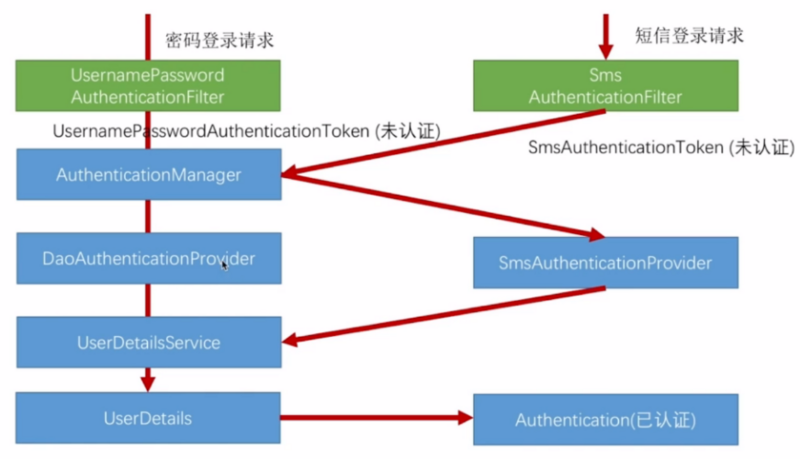15.SpringSecurity-短信登录开发
前言
之前我们讲了短信验证码开发,现在需要使用短信登录;具体流程如下:
之前密码登录我们详细介绍过其详细流程如下:
内容

1.1 密码登录详细流程
- 首先密码登录请求:/authentication/form会给到UsernamePasswordAuthenticationFilter(此过滤器会拿出用户名/密码,组装成未认证的UsernamePasswordAuthenticationToken;传给AuthenticationManager)
- AuthenticationManager会从一堆AuthenticationProvider里面去挑选一个provider来处理认证请求(挑选的依据是:AuthenticationProvider有一个support方法,此support判断当前的provider是否支持你传递过来的token,如果支持的话就用对应的provider处理:成未认证的UsernamePasswordAuthenticationToken;这里用到DaoAuthenticationProvider)
- DaoAuthenticationProviderren认证过程中会调用UserDetailsService去获取用户信息UserDetails;跟请求传过来的登录信息做一些比较;判断是否可以认证通过。
- 认证通过的话最终会把:未认证的UsernamePasswordAuthenticationToken作为一个标记:Authentication(已认证)
1.2 短信登录详细流程
短信登录的话,首先我们需要明确,短信登录不能在此流程里面出现和改动,因为这是两种不同的登录方式,不能把两种不同的登录方式混合在一套代码里面去维护,这样代码质量会大大降低。维护起来也很困难。 我们需要仿造密码登录流程自己写一套流程。 我们需要写4个东西:
- 短信登录请求(/authentication/mobile)给SmsAuthenticationFilter(此过滤器会拿出mobile,组装成未认证的SmsAuthenticationToken;传给AuthenticationManager:因为AuthenticationManager整个系统就只有一个)。
- AuthenticationManager会从一堆AuthenticationProvider里面去挑选一个provider来处理认证请求(挑选的依据是:AuthenticationProvider有一个support方法,此support判断当前的provider是否支持你传递过来的token,如果支持的话就用对应的provider处理:成未认证的SmsAuthenticationFilter;这里用到SmsAuthenticationProvider:需要我们自己实现)
- SmsAuthenticationProvider认证过程中会调用UserDetailsService去获取用户信息UserDetails;跟请求传过来的登录信息做一些比较;判断是否可以认证通过。
注意:
- 此过程中说了3个东西:Filter、Token、Provider;这3个类作用的过程中,我们不会去校验短信验证码这里只是根据手机号去做用户信息认证。短信验证码的校验类似于图形验证码的校验,他是在Filter请求之前进行校验。 加了一个过滤器来在SmsAuthenticationFilter之前校验密码。
- 我们为什么不把短信验证码功能卸载SmsAuthentiationProvider里面,这是因为:验短信验证码的功能我们还希望给其他请求去使用;假如我们需要开发一个支付功能,每次支付完成前都需要做短信验证码校验,如果我们写在SmsAuthentiationProvider里面,那么短信验证码的功能是不能重复利用的:因为其包含额外短信验证码不需要的信息。
1.3 代码开发
因为短信登录功能无论在浏览器端还是手机端都会用,我们我们把他放到spring security core里面
我们拷贝出:UsernamePasswordAuthenticationToken代码,然后在此基础上修改:
public class SmsCodeAuthenticationToken extends AbstractAuthenticationToken {
private static final long serialVersionUID = 420L;
private final Object principal;
/**
* 没登录之前,principal我们使用手机号
* @param mobile
*/
public SmsCodeAuthenticationToken(String mobile) {
super((Collection)null);
this.principal = mobile;
this.setAuthenticated(false);
}
/**
* 登录认证之后,principal我们使用用户信息
* @param principal
* @param authorities
*/
public SmsCodeAuthenticationToken(Object principal, Collection<? extends GrantedAuthority> authorities) {
super(authorities);
this.principal = principal;
super.setAuthenticated(true);
}
public Object getCredentials() {
return null;
}
public Object getPrincipal() {
return this.principal;
}
public void setAuthenticated(boolean isAuthenticated) throws IllegalArgumentException {
if (isAuthenticated) {
throw new IllegalArgumentException("Cannot set this token to trusted - use constructor which takes a GrantedAuthority list instead");
} else {
super.setAuthenticated(false);
}
}
public void eraseCredentials() {
super.eraseCredentials();
}
}
1.3.2 SmsCodeAuthenticationFilter开发
我们拷贝出:UsernamePasswordAuthenticationFilter代码,然后在此基础上修改:
public class SmsCodeAuthenticationFilter extends AbstractAuthenticationProcessingFilter {
/**
* 在我们认证过程中是不需要密码,认证信息是手机号
*/
public static final String YXM_FORM_MOBILE_KEY = "mobile";
/**
* 请求中携带参数的名字是什么?
*/
private String mobileParameter = "mobile";
/**
* 此过滤器只处理post请求
*/
private boolean postOnly = true;
public SmsCodeAuthenticationFilter() {
//指明当前过滤器处理的请求是什么?/authentication/mobile --这个地址不能写错,不然不会走此认证过滤器方法
super(new AntPathRequestMatcher("/authentication/mobile", "POST"));
}
public Authentication attemptAuthentication(HttpServletRequest request, HttpServletResponse response) throws AuthenticationException {
if (this.postOnly && !request.getMethod().equals("POST")) {
throw new AuthenticationServiceException("Authentication method not supported: " + request.getMethod());
} else {
String mobile = this.obtainMobile(request);
if (mobile == null) {
mobile = "";
}
mobile = mobile.trim();
//实例化未认证的token
SmsCodeAuthenticationToken authRequest = new SmsCodeAuthenticationToken(mobile);
this.setDetails(request, authRequest);
/**
* AuthenticationManager进行调用
*/
return this.getAuthenticationManager().authenticate(authRequest);
}
}
protected String obtainMobile(HttpServletRequest request) {
return request.getParameter(this.mobileParameter);
}
protected void setDetails(HttpServletRequest request, SmsCodeAuthenticationToken authRequest) {
authRequest.setDetails(this.authenticationDetailsSource.buildDetails(request));
}
public void setMobileParameter(String mobileParameter) {
Assert.hasText(mobileParameter, "Username parameter must not be empty or null");
this.mobileParameter = mobileParameter;
}
public void setPostOnly(boolean postOnly) {
this.postOnly = postOnly;
}
public final String getMobileParameter() {
return this.mobileParameter;
}
}
1.3.3 SmsCodeAuthenticationProvider 开发
SmsCodeAuthenticationProvider 开发实现AuthenticationProvider接口
public class SmsCodeAuthenticationProvider implements AuthenticationProvider {
private UserDetailsService userDetailsService;
public UserDetailsService getUserDetailsService() {
return userDetailsService;
}
public void setUserDetailsService(UserDetailsService userDetailsService) {
this.userDetailsService = userDetailsService;
}
@Override
public Authentication authenticate(Authentication authentication) throws AuthenticationException {
/**
* 校验逻辑很简单:用SmsCodeAuthenticationToken信息调用UserDetailService去数据库校验
* 将此对象变成一个已经认证的认证数据
*/
SmsCodeAuthenticationToken authenticationToken = (SmsCodeAuthenticationToken) authentication;
UserDetails user = userDetailsService.loadUserByUsername((String) authenticationToken.getPrincipal());
if(user == null){
throw new InternalAuthenticationServiceException("无法获取用户信息");
}
//.没有错误说明认证成功
final SmsCodeAuthenticationToken authenticationResult = new SmsCodeAuthenticationToken(user, user.getAuthorities());
authenticationResult.setDetails(authenticationToken.getDetails());
return authenticationResult;
}
/**
* 此方法就是检验AuthenticationManager会使用哪个provider
* @param authentication
* @return
*/
@Override
public boolean supports(Class<?> authentication) {
//此方法就是检验AuthenticationManager会使用哪个provider
return SmsCodeAuthenticationToken.class.isAssignableFrom(authentication);
}
}
1.3.4 SmsCodeFilter 开发
我们需要短信验证码拦截器:在请求进入SmsCodeAuthenticationFilter之前;短信验证码的验证逻辑和图片验证码的验证逻辑一样。所以我们直接在上面修改:SmsCodeFilter 代码基本是一样的,只是我们拦截的请求变化了。
public class SmsCodeFilter extends OncePerRequestFilter implements InitializingBean {
private AuthenticationFailureHandler authenticationFailureHandler;
private SessionStrategy sessionStrategy = new HttpSessionSessionStrategy();
private Logger logger = LoggerFactory.getLogger(getClass());
//需要校验的url都在这里面添加
private Set<String> urls = new HashSet<>();
private AntPathMatcher antPathMatcher = new AntPathMatcher();
//此处不用注解@Autowire 而是使用setter方法将在WebSecurityConfig设置
private SecurityProperties securityProperties;
@Override
public void afterPropertiesSet() throws ServletException {
super.afterPropertiesSet();
/**
* 拦截短信验证码需要拦截的地址url(包括自定义url和登录时候url):这些url都需要经过这个过滤器
*/
String[] configUrls = StringUtils.splitByWholeSeparatorPreserveAllTokens(securityProperties.getCode().getSms().getUrl(), ",");
if(configUrls!=null && configUrls.length>0){
for (String configUrl:configUrls) {
urls.add(configUrl);
}
}
//"/authentication/moble 一定会校验验证码的
urls.add("/authentication/mobile");
}
@Override
protected void doFilterInternal(HttpServletRequest request, HttpServletResponse response, FilterChain filterChain) throws ServletException, IOException {
logger.info("验证码过滤器:doFilterInternal: requestURI:[{}] requestMethod:[{}]",request.getRequestURI(),request.getMethod());
/**
* 如果是需要认证请求,我们进行家宴
* 如果校验失败,使用我们自定义的校验失败处理类处理
* 如果不需要认证,我们放行进入下一个Filter
*/
//在afterPropertiesSet执行之后,url初始化完毕之后,但是此时我们判断不能用StringUtils.equals,我们我们urls里面有 url: /user,/user/* 带星号的配置
// 用户请求有可能是/user/1、/user/2 我们需要使用Spring的 AntPathMatcher
boolean action = false;
for (String url:urls) {
//如果配置的url和请求的url相同时候,需要校验
if(antPathMatcher.match(url,request.getRequestURI())){
action = true;
}
}
if(action){
try{
validate(new ServletWebRequest(request));
}catch (ValidateCodeException e){
authenticationFailureHandler.onAuthenticationFailure(request,response,e);
//抛出异常校验失败,不再走小面过滤器执行链
return;
}
}
filterChain.doFilter(request,response);
}
private void validate(ServletWebRequest servletWebRequest) throws ServletRequestBindingException {
//1.获取存放到session中的验证码
ValidateCode codeInSession = (ValidateCode)sessionStrategy.getAttribute(servletWebRequest, ValidateCodeProcessor.SESSION_KEY_PREFIX+"SMS");
//2.获取请求中的验证码
String codeInRequest = ServletRequestUtils.getStringParameter(servletWebRequest.getRequest(), "smsCode");
if(StringUtils.isBlank(codeInRequest)){
throw new ValidateCodeException("验证码的值不能为空");
}
if(codeInSession == null){
throw new ValidateCodeException("验证码不存在");
}
if(codeInSession.isExpried()){
sessionStrategy.removeAttribute(servletWebRequest,ValidateCodeProcessor.SESSION_KEY_PREFIX+"SMS");
throw new ValidateCodeException("验证码已过期");
}
if(!StringUtils.equals(codeInSession.getCode(),codeInRequest)){
throw new ValidateCodeException("验证码不匹配");
}
sessionStrategy.removeAttribute(servletWebRequest,ValidateCodeProcessor.SESSION_KEY_PREFIX+"SMS");
}
public AuthenticationFailureHandler getAuthenticationFailureHandler() {
return authenticationFailureHandler;
}
public void setAuthenticationFailureHandler(AuthenticationFailureHandler authenticationFailureHandler) {
this.authenticationFailureHandler = authenticationFailureHandler;
}
public SecurityProperties getSecurityProperties() {
return securityProperties;
}
public void setSecurityProperties(SecurityProperties securityProperties) {
this.securityProperties = securityProperties;
}
}
测试
正文到此结束
- 本文标签: URLs src 图片 质量 HashSet UI 参数 Security spring id https CTO build ORM authenticate equals 配置 list Word 希望 struct 代码 provider bean 认证 session cat key http Collection ip IDE final Service 测试 token 数据库 实例 core IO servlet 数据 开发 Action web Spring Security
- 版权声明: 本文为互联网转载文章,出处已在文章中说明(部分除外)。如果侵权,请联系本站长删除,谢谢。
- 本文海报: 生成海报一 生成海报二
热门推荐
相关文章
Loading...











![[HBLOG]公众号](https://www.liuhaihua.cn/img/qrcode_gzh.jpg)

